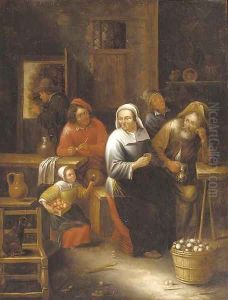Gillis Van Tilborch II Paintings
Gillis van Tilborgh II was a Flemish painter born in 1625 in Brussels, part of the Spanish Netherlands during a period that was particularly rich in artistic expressions. He belonged to a family with strong connections to the art world; his father, Gillis van Tilborgh the Elder, was also a painter, which suggests that artistry ran in the family and likely provided the younger Gillis with his initial training and inspiration. Despite the shadow of his father's work, Gillis II carved out his own niche in the art world, primarily focusing on genre scenes, portraits, and occasionally historical subjects.
His career unfolded in a Europe that was deeply influenced by the Baroque movement, yet Gillis II managed to infuse his works with a distinctive touch that often leaned towards realism and the portrayal of everyday life, a characteristic more aligned with the Dutch Golden Age painting traditions. This suggests a synthesis of influences and perhaps personal contacts with artists from the neighboring Dutch Republic, where such scenes were popular. His paintings often depicted lively tavern scenes, elegant company gatherings, and domestic interiors, filled with rich details and a keen observation of social interactions and attire, capturing the essence of 17th-century Flemish life with a candidness that was both informative and aesthetically pleasing.
Despite his talent and contributions to Flemish art, Gillis van Tilborgh II did not gain the same level of fame as some of his contemporaries, such as Rubens or Van Dyck. However, his works have been recognized for their quality and historical value, offering insights into the cultural and social dynamics of his time. His ability to blend the grandeur of the Baroque with the intimate observations of genre painting places him as a noteworthy figure within the Flemish art tradition.
Gillis van Tilborgh II died in 1678, leaving behind a body of work that, while not extensive, is valued for its artistic and historical significance. Today, his paintings can be found in various museums and collections around the world, serving as a testament to the enduring appeal of his perspective on 17th-century life and society.
